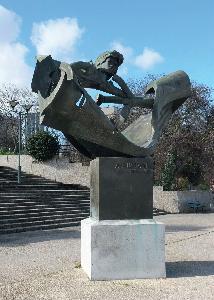Jean Robert
Jean Robert;Ipoustéguy;Ipousteguy
Place: Dun-Sur-Meuse
Born: 1920
Death: 2006
Biography:
Jean-Robert Ipoustéguy was a figurative French sculptor, born Jean Robert in Dun-sur-Meuse, France. He was one of the most important French sculptors of the 20th century, known for his complex and violent works with aspirations in multiple fields. He studied at the École des Beaux-Arts in Reims and later at the Académie de la Grande Chaumière in Paris.
Early Life and Education
In 1920, Jean Robert was born in Dun-sur-Meuse, between Verdun and Sedan, in the recent aftermath of the ruinous trench warfare of World War I. His father was a joiner, earning a living by producing fine woodwork, who also enjoyed painting, violin playing, and amateur theatrical productions. Jean Robert played in the surrounding fields as a boy, but as he dug into the earth, he would sense the presence of death beneath him. At the age of 18, Jean Robert moved to Paris, where he got a job as a legal clerk and courier. On a winter afternoon in 1938, he saw a poster offering an evening art class taught by Robert Lesbounit, and signed up immediately. The teacher encouraged him to read books far beyond the level of his classmates, and introduced him to a deeper understanding of art history through visits to the Louvre and art galleries.
Career
In 1947-48, Jean Robert joined a "collective" of teachers and young artists creating frescos and stained glass windows for the church of Saint-Jacques, Petit-Montrouge, Paris. In 1949, he set up his studio in Choisy-le-Roi, approximately 10 kilometres (6.2 mi) southeast of the center of Paris, and began to work on sculpture. Important works by Jean Robert include The Summer (Torso), a massive creature that guards the entrance to the Maison des Champs. The Dragon is made of cement and is adorned with mosaics, creating a striking visual contrast.
- Painting by 'Henri Laurens': Henri Laurens created the captivating piece Femme à la guitare in 1921.
- Painting by 'Émile Antoine Bourdelle': The Carpeaux at Work sculpture, crafted by the renowned French artist Émile Antoine Bourdelle, is a testament to his exceptional skill and artistry.
- Painting by 'Yves Klein': Yves Klein created the Monochrome Pink Untitled in a style that blends Cubism with traditional figurative art.
to note is that Jean Robert's artwork had a distinct style, combining abstract elements with the human figure, often in the écorché style of French anatomists. The American writer John Updike once wrote that he "may be France's foremost living sculptor, but he is little known in the United States". In 1953, Jean Robert turned away from oil painting and dedicated himself to the production of sculpture, in spite of a warning from Kahnweiler, his art dealer at the time, that it would not sell. Jean Robert continued to produce notable works, including The Summer (Torso), which is now considered one of his most important pieces. Artist: Jean Robert: Jean Robert was a prominent French sculptor and artist, known for his complex and violent works with aspirations in multiple fields. Important to note is that Jean Robert's artwork had a distinct style, combining abstract elements with the human figure, often in the écorché style of French anatomists. The American writer John Updike once wrote that he "may be France's foremost living sculptor, but he is little known in the United States". In 1953, Jean Robert turned away from oil painting and dedicated himself to the production of sculpture, in spite of a warning from Kahnweiler, his art dealer at the time, that it would not sell. Jean Robert continued to produce notable works, including The Summer (Torso), which is now considered one of his most important pieces. Jean-Robert Ipoustéguy: Jean Robert was a prominent French sculptor and artist, known for his complex and violent works with aspirations in multiple fields. Important to note is that Jean Robert's artwork had a distinct style, combining abstract elements with the human figure, often in the écorché style of French anatomists. The American writer John Updike once wrote that he "may be France's foremost living sculptor, but he is little known in the United States

